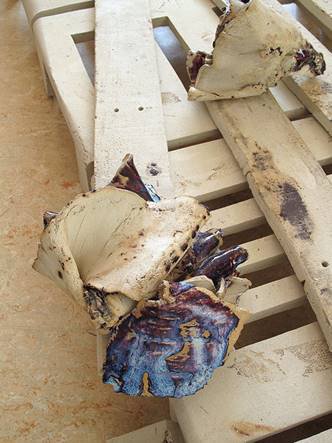Guillermo Aguilar-Huerta / Miguel Angel Fernandez
dal 4/7/2014 al 1/8/2014
Segnalato da
4/7/2014
Guillermo Aguilar-Huerta / Miguel Angel Fernandez
Greusslich Contemporary, Berlin
Colorful Residual Discourse. For Aguilar-Huerta, the object quickly becomes as if it were extracted from a moulding press of junk. Fernandez he attempts to break the resonant and sometimes difficult conceptual impressions made by ceramics.

Guillermo Aguilar-Huerta covers banal shipping components from an industrial
production context with a cheery surface aesthetic. In so doing, the
transport paraphernalia is refined neither before nor after this process,
but is rather extracted from its meaning as packing residue and becomes a
form of contemporary art carrier. This fusion is attended to as if it were a
self-evident process and results in objects, the surfaces of which follow
strict abstract-geometric plays of color. They encipher ornamental codes of
form and color, in unending variation, which have influences ranging from
prehistoric cultures such as the Mayans through to contemporary art history.
For Aguilar-Huerta, the object quickly becomes as if it were extracted from
a moulding press of junk, and experiences an aestheticization without
concern for the material or discourse. Despite this, he is very conscious of
his medium in that, for the work he has concentrated on in this exhibition,
he has used the title "Industrial Series", as opposed to his "Humanity
Series" or "Universe Series". Here, dominant abstractions painstakingly
applied to untreated material scrap create works which feel like paintings,
but are objects. For Aguila-Huerta, industrialization, with its winners and
losers, is one of his influential historical eras, and has strongly formed
his work and his thought, both as a member of the global community and as a
Mexican. Indeed, with these candy-colored gems, this discourse sneaks up on
us, as it were, though the back door.
In opposition to this stands the work of Miguel Ángel Fernández. He directly
thematizes the material aesthetic, in that he attempts to break the resonant
and sometimes difficult conceptual impressions made by ceramics, and by
which he adjusts an assembly kit for a set of shelves. And so, upon planks
made of clay, likewise fired "wood shavings" are placed which reveal the
process of how the top layer was stripped off for the purpose of smoothing
the imitation planks. These four residual clay fragments, strangely glazed
on only one side, destroy the tendency to read the work conceptually as a
material experiment and a repurposing of the DIY aesthetic and the
Readymade. The clearly poetic crowns, which are prominently placed upon the
ceramic sculpture, frustrate one's attempts to decipher it as a conceptual
work.
The second work by Fernández will physically change during the course of the
evening of the opening reception. Frozen black paint, which has been
utilized previously in earlier installations, will, by melting and dripping,
develop a painterly significance from the residue of its sculptural
appearance. Fernández's interests in the development of process-related form
and meaning in contention with the phenomenon of time will be made clear.
This one-off, site-specific installation negates the usual production of art
objects, attacks the purity of the "White Cube", and is a black, organic
opposition to the geometric color games of Aguilar-Huerta.
Guillermo Aguilar-Huerta (*1982 Monterrey, Mexico) has lived and worked in
Berlin and Mexico since 2007. He studied fine art at the "Instituto Nacional
de Bellas Artes", and art history at the I.T.E.S.M. in Monterrey.
Miguel Ángel Fernández (*1976 Yeste, Spain) has lived and worked in Berlin
since 2006.
The exhibition is kindly supported by the Spanish Embassy in Berlin.
The exhibition is kindly supported by the Mexican Embassy in Berlin.
Vernissage: 05.07.2014, 6-9 pm
Finissage: 02.08.2014, 6-9 pm
Greusslich Contemporary
Buchholzer Str. 11 - 10437 Berlin
Open: Wed+Thu 4-9 pm, Sat + Sun 1-6 pm



